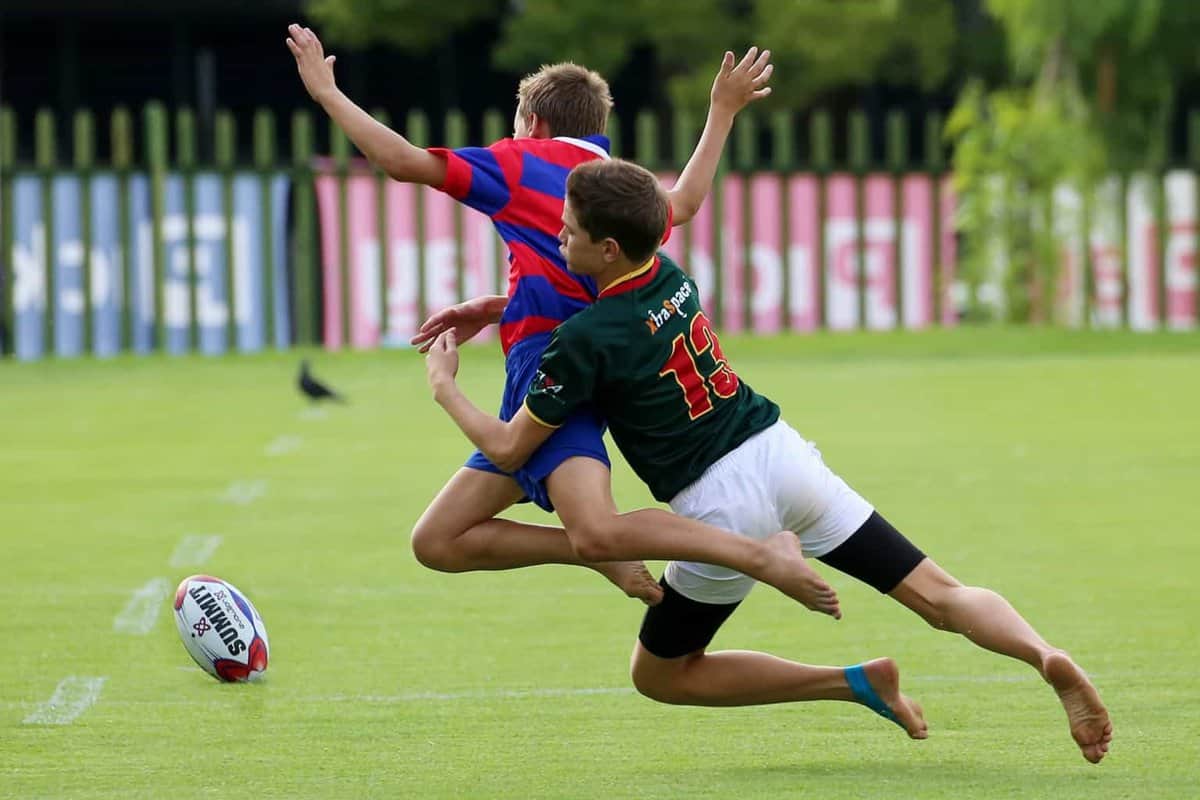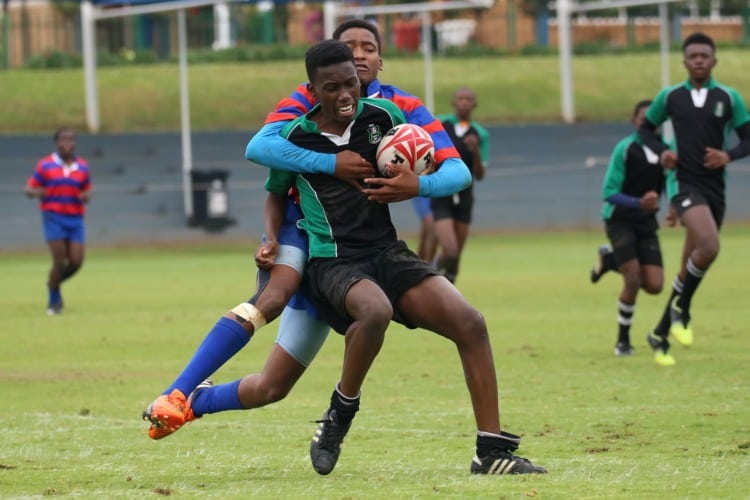Rugby is a sport with great educational values to address as content in physical education. In the following article, the main characteristics of the sport are discussed, followed by rugby games, a theme that will focus as an alternative to work on a specific sport within PE both in the final years of primary and secondary education.
Within this article, we will show you an initial conceptualization, also addressing the basic rules of this sport.
Next, we will directly address several rugby games as content in physical education and conclude with a small practical proposal.
Rugby: conceptualization and characteristics
Rugby originated in the second half of the 19th century, in England.
It stems from the disparity of practices known as football, with some players preferring to play with their feet and others more inclined towards what is now known as rugby (1).
Rugby is a collaboration-opposition sport, which differs from football by its hand play, where passing the ball forward is not allowed, so players without the ball must position themselves behind the carrier to continue advancing towards the opposing goal.
The ball can only advance by kicking it or moving with the player carrying it.
It is a motivating sport with characteristics different from conventional sports, but some dangers or risks must be considered.
One of the risks of the sport, which can be reduced through the practice of rugby games where students from the start understand the internal logic of the game and the actions to avoid, is the injuries players are exposed to due to the constant contact between opponents, especially those related to shoulder injuries.
Rules and regulations of rugby
Below are the main rules of rugby, which can be modified in the educational field due to the motor and cognitive characteristics of the students:
- Passing the ball forward is not allowed. The ball can only advance by carrying it or kicking it forward.
- A tackled player cannot retain the ball; they must pass it or release it.
- When the game stops (for example, due to a forward pass), the game restarts with a scrum.
- A team scores points when they achieve a try, which occurs when the ball is carried beyond the try line and grounded.
- Depending on how the try is achieved, the team scores 2, 3, or 5 points.
- The match consists of two continuous halves of 40 minutes each with a 5-minute halftime.
- Each team consists of 15 players, divided into attackers and defenders.
Rugby games in physical education
Rugby games are a great educational alternative to address this sport as valuable content. Rugby games can be played with or without contact, playing a variant called tag rugby or flag rugby.
An option to choose the characteristics or rules with which you want to play is to assess the physical characteristics of the students, their motivation, ego or task orientation, the relationship between students, etc.
If the relationship and characteristics are good and similar, an approach to rugby can be practiced with rugby games, while if the students are in primary school and present conflicts… it is better to practice rugby games without physical contact to avoid risks.
As mentioned, the motivational climate is very relevant for the practice of rugby games, so the teacher must create the best practice conditions for the students’ perception to be positive.
The task climate generated by the teacher positively predicts the perception of competence, autonomy, and social relationships among students (2).
One of the strategies to generate this climate through the work of rugby games is to make the objectives of each session known and help students be realistic and set short-term goals (2).
Considering the above, different rugby games are now proposed that can be worked on during a complete teaching unit of the sport or in isolated sessions for its practice:
- Ribbon thieves: Two teams with the same number of players are formed. Each player on each team will carry a ribbon or handkerchief tied or attached to their waist or back. At the signal “go,” each player must try to remove the ribbons from the opponents, trying not to lose their own (3). The team that gets the most ribbons wins; this can also be started individually and then played in teams.
- Foxes and hens: In pairs, the hen carries two ribbons, one on the chest and one on the back, and must flee as the fox tries to remove both ribbons within a set time. Then the roles are switched, and they try to beat the time.
- Foxes, hens, and vipers: Three groups are formed, and each player carries a ribbon attached to their back. Each group must catch another (catching does not mean touching the player but stealing their ribbon).
- 10 passes: With the rugby ball, considering that forward passes are not allowed. It starts with opposing groups of 5 players, and variants are introduced: 7 players, 10, 13, and 15.
- Other options for rugby games that can be developed are through the practice of real game actions:
- The lineout: Groups of 6 students are formed and divided into two teams each. A line is made for each team, positioned towards the side where the ball is supposed to have gone out if it were being played. After this, the players hold hands with the opposing player on their side. The ball is thrown in the middle, and it’s time to release hands to go and catch the ball.
- Time is given between trials for each team to develop their strategy.
- Scrums: In groups of 6, two opposing teams, each forming a line of three and behind a line of two, they join by supporting arms and necks on their teammates. The student placed behind is the one to whom the ball must be passed.
- Reduced rugby games: Following the real game rules, but with 7 players instead of 15.
- The lineout: Groups of 6 students are formed and divided into two teams each. A line is made for each team, positioned towards the side where the ball is supposed to have gone out if it were being played. After this, the players hold hands with the opposing player on their side. The ball is thrown in the middle, and it’s time to release hands to go and catch the ball.
Practical proposal for tag rugby
Tag rugby, as mentioned, is an invasion sport similar to rugby but differs from it by not involving physical contact with the opponent.
In this rugby game, tackles are eliminated, replaced by stealing ribbons that all players will wear on their waists (4). Because of this, there are no falls to the ground or any physical contact.
To make a tag rugby proposal, based on rugby games, first, the rules of the sport should be established so that all students are clear:
- Defending students must only remove ribbons from attackers moving with the ball.
- The attackers’ goal is to score a try.
- As in rugby, to achieve this, the ball must be placed on the ground behind the try line.
- Attackers will have five opportunities in each possession. That is, the attacking team will have five opportunities to score. When the defense removes a ribbon, they will lose an opportunity and must start the play again.
- The defense’s goal is to steal the ribbons from the players with the ball, respecting the offside rule.
After explaining the rules as a start, the session can continue by proposing simple rugby games in small groups like those mentioned earlier (stealing the ribbon, foxes and hens, etc.)
The session can end with a reflection on the contact with rugby without contact and the differences with the same sport with contact, emphasizing the reduction of injury risk.
Conclusions
Rugby, despite seeming like a sport and content with a lot of risk or aggression, is one of the sports with the least conflict due to the great respect existing between players and referees, especially because of the awareness of injuries and risks inherent to the practice itself.
The work of rugby games in physical education helps students have practice resources in the extracurricular field, improve relationships with peers through cooperative work and respect, and enhance their self-concept and confidence in practicing physical activity.
Bibliographic references
- Grancha, J. S. (1992). History of rugby. Apunts. Physical education and sports, 3(29), 06-11.
- Abós Catalán, Á., Sevil Serrano, J., Sanz Remacha, M., & García-González, L. (2015). Influential motivational variables in a rugby teaching unit: keys for improving teaching intervention. Sportis, 1(2), 110-128. Retrieved from: https://ruc.udc.es/dspace/bitstream/handle/2183/17664/SPORTIS_1_2_2015_3.pdf?sequence=1&isAllowed=y
- Ruiz, F. J. M. (2016). Proposal of a training unit. Tag rugby: integration of rugby in primary education. EmásF: digital magazine of physical education, (38), 87-102. Retrieved from: https://dialnet.unirioja.es/servlet/articulo?codigo=5351994
- Garcés Albán, M. L. (2019). Pre-sport games for teaching the technical elements of rugby in children aged 12 to 14 (Bachelor’s thesis, Universidad de Guayaquil. Faculty of Physical Education, Sports and Recreation).




